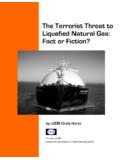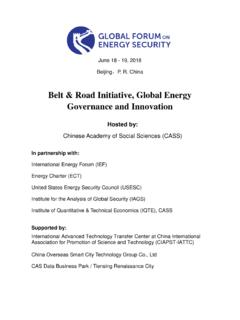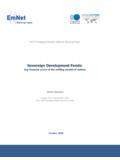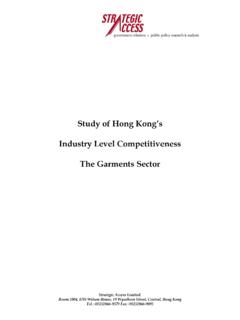Transcription of China’s Rare Earth Elements Industry: What Can …
1 China s Rare Earth Elements industry : what Can the West Learn?By Cindy HurstMarch 2010 Institute for the Analysis of Global Security (IAGS)The Institute for the Analysis of Global Security is a Washington based non-profit thinktank dedicated to research and public debate on issues related to energy security. IAGS seeks to promote public awareness to the strong impact energy has on the worldeconomy and security and to the myriad of technological and policy solutions that couldhelp nations strengthen their energy Hurst is an analyst for the Army s Foreign Military Studies Office, Fort Leavenworth, views expressed in this report are those of the author and do not necessarily repres-ent the official policy or position of the Department of the Army, Department of Defense, or the controls approximately 97 percent of the world's rare Earth elementmarket.
2 These Elements , which are not widely known because they are so low onthe production chain , are critical to hundreds of high tech applications, many ofwhich define our modern way of life. Without rare Earth Elements , much of theworld's modern technology would be vastly different and many applications wouldnot be possible. For one thing, we would not have the advantage of smaller sizedtechnology, such as the cell phone and laptop computer, without the use of rareearth Elements . Rare Earth Elements are also essential for the defense industryand are found in cruise missiles, precision guided munitions, radar systems andreactive armor. They are also key to the emergence of green technology such asthe new generation of wind powered turbines and plug-in hybrid vehicles, as wellas to oil refineries, where they act as a catalyst.
3 (Note: for more in-depthinformation on the specific uses of rare Earth Elements , refer to Appendix A).Over the past few years, China has come under increasing scrutiny andcriticism over its monopoly of the rare Earth industry and for gradually reducingexport quotas of these resources. However, China is faced with its own internalissues that, if not addressed, could soon stress the country's rare Earth industry . This paper is designed to give the reader a better understanding of whatrare Earth Elements are and their importance to society in general and to and energy policy in particular. It will also explore the history of rareearth Elements and China's current monopoly of the industry , including possiblerepercussions and strategic implications if rare Earth Elements supply were to bedisrupted.
4 Definition of Rare Earth ElementsAccording to the Geological Survey, rare Earth Elements comprise thoseelements that are part of the family of lanthanides on the periodic table withatomic numbers 57-71. Scandium (atomic number 21) and yttrium (atomicnumber 39) are grouped with the lanthanide family because of their Rare Earth Elements are separated into two categories, light rareearths and heavy rare earths. The light rare Earth Elements are lanthanum,cerium, praseodymium, neodymium, and samarium (atomic numbers 57-62), andthey are more abundant than heavy ones. The heavy rare Earth Elements (atomicnumbers 64-71 plus yttrium, atomic number 39) are not as predominant as lightrare earths and are generally used in high tech For example:Erbium is used for fiber optics in communications.
5 Europium and Terbium areused as phosphors. Gadolinium is used for in MRIs. The term rare Earth is actually a misnomer. They are not rare at all, beingfound in low concentrations throughout the Earth s crust, and in higherconcentrations in numerous minerals. Rare Earth Elements can be found in1 James B. Hedrick, Rare- Earth Metal Prices in the USA ca. 1960 to 1994, Journal of Alloys andCompounds, 250, (1997): The heavy rare Earth Elements sometimes will include all massive rock formations. However, their concentrations range from tento a few hundred parts per million by weight. Therefore, finding them where theycan be economically mined and processed presents a real challenge.
6 Rare Earth Elements can be found in a variety of minerals, but the mostabundant rare Earth Elements are found primarily in bastnaesite and typically contains light rare earths and a small amount of theheavies, while monazite also contains mostly the light, but the fraction of theheavy rare earths is two to three times larger. According to the GeologicalSurvey, bastnaesite deposits in China and the make up the largestpercentage of economic rare Earth resources. Monazite deposits, found inAustralia, Brazil, China, India, Malaysia, South Africa, Sri Lanka, Thailand, andthe make up the second largest segment.
7 Other examples of mineralsknown to contain rare Earth Elements include apatite, cheralite, eudialyte,loparite, phoshporites, rare- Earth -bearing (ion absorption) clays, secondarymonazite, spent uranium solutions, and Rare Earth Oxides: No Small TaskA better appreciation of rare Earth Elements and the difficulty in acquiringthem is attained by examining how they are processed. Dr. John Burba, ChiefTechnology Officer at Molycorp Minerals, the company that runs the only rareearth mining operation in the , pointed out that, a lot of people don t quiteunderstand why rare Earth operations are different (from other miningoperations). 4 Mining gold, for example, is a much simpler procedure than miningrare Earth Elements .
8 One method in processing gold ore, simply put, is to mix theore with sodium cyanide. The gold is then leached right out. Rare Earth Elements are far more complicated and costly to extract. (SeeDiagram 1 below) First, ore containing minerals (for this example, we will look atbastnaesite), is taken out of the ground using normal mining procedures. Thebastnaesite must then be removed from the ore, which generally contains anumber of other minerals of little value. The bastnaesite is removed by crushingthe ore into gravel size, then placing the crushed ore into a grinding mill. Oncethe ore is ground down through a mill into a fine sand or silt the different mineralgrains become separated from each other.
9 The sand or silt is then furtherprocessed to separate the bastnaesite from the other nonessential minerals. Thisis accomplished by running the mixture through a floatation process. During thefloatation process an agent is added and air bubbles come up through the bottomof the tank. Bastnaesite sticks to those bubbles and floats to the top of the tankas a froth, where it is then scraped Mineral Commodity Summaries 2009, Geological Survey, Washington, : Printing Office, 2009), John Burba, interview by author, Mountain Pass, California, 8 July bastnaesite contains the rare Earth Elements , which must be furtherseparated into their respective pure forms in a separation plant, using acid andvarious solvent extraction separation steps.
10 Each element has its own uniqueextraction steps and chemical processes and at times, these Elements willrequire reprocessing to achieve the ideal purity. Once the Elements areseparated out, they are in the form of oxides, which can be dried, stored, andshipped for further processing into metals. The metals can be further processedinto alloys and used for other applications such as the neodymium-iron-boronmagnet. These alloys and magnets are then assembled into hundreds of hightech applications. In total, the process takes approximately 10 days from thepoint when the ore is taken out of the ground to the point at which the rare earthoxides are actually produced.











